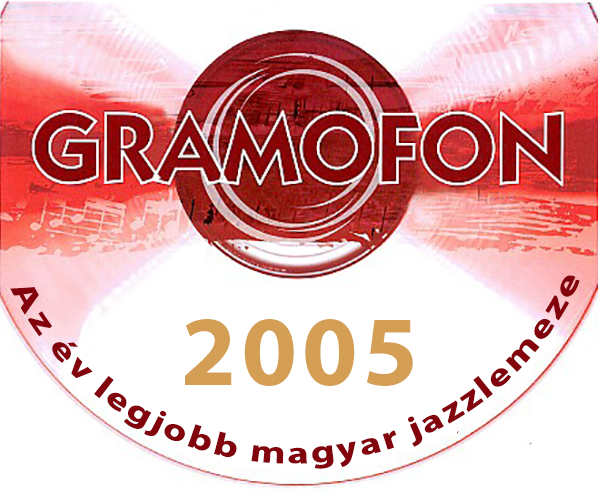Mihály Borbély Quartet Meselia Hill
“Gramofon – Hungarian jazz album of the year, 2005” by the Hungarian magazine Gramofon
“XVIII. eMeRTon award – Best Hungarian jazz group of the year, 2005” by the Hungarian Radio
...Meselia became a piece of music for me that reflects the diversity and yet the sameness of the people living around that hill, radiating the joy, the turbulence, the fears, the regrets and the occasional melancholy of those very people who are my people. It is the music of the old lady who used to live across the street and used to banter with the Slovak carters in their language, held her own in German and was not lost for words when the Gypsies addressed her in one of their Romany dialects.
Artists
Mihály Borbély - soprano, alto and tenor saxophones, tárogató, kaval, fujara
Gábor Cseke - piano
Balázs Horváth - double bass
István Baló - drums
Miklós Lukács - cimbalom (1, 3, 4, 5, 6, 7, 8, 10)
Zoltán Lantos - violin (4, 5)
About the album
Composed by Mihály Borbély (2, 4, 5, 9); Mihály Ráduly (7); Mihály Borbély and Miklós Lukács (1, 3, 6, 8, 10)
Recorded at the Tom-Tom Studio, Budapest on 5-6/04/2004 and 12/09/2004
Recorded and mixed by Attila Kölcsényi
Cover art by Meral Yasar based on photos by Lenke Szilágyi, Zoltán Gaál and Gábor Bachman
Portrait photo: István Huszti
Art-Smart by GABMER
Produced by László Gőz
Executive producer: Tamás Bognár
The recording was sponsored by the Ministry of Cultural Heritage, the National Cultural Fund of Hungary and the Artisjus Music Foundation
Reviews
Scott Yanow - All Music Guide **** (en)
Ken Waxman - One Final Note - JazzWord (en)
Michael Stone - RootsWorld.com (en)
Martin Ellenbruch - My Way (de)
Angelo Leonardi - All About Jazz - Italia (it)
Szigeti Péter - Gramofon ***** (hu)
Retkes Attila - Magyar Hírlap (hu)
Sinkovics Ferenc - Demokrata (hu)
Olasz Sándor - Rockinform (hu)
Mihály Borbély Quartet: Meselia Hill
The album is available in digital form at our retail partners
Meselia is a little hill near Pomáz, the village I come from. Its name is Serbian, but no one seems to know for sure what it means any more. Hungarians often refer to it as “mesélő hegy” meaning the hill that tells tales. A hill with a Serbian name, a hill that tells tales next to a village inhabited by Hungarians, Serbs, Slovaks, Germans and Gypsies. The tales that Meselia could tell would be of neighbours who, for centuries, have lived together, fought together, worked together, have shared their worries and had fun together. Somehow, for me that hill is like the drop of water that encapsulates the whole ocean. If Meselia was a piece of music, it would have a Hungarian character with strong Serbian, Slovak, German, and Gypsy overtones. It would also have to be improvised in part, like the villagers of Pomáz often had to make things up on the spur of the moment in order to stay alive. They certainly needed their wits during centuries of wars, occupations, revolutions and natural disasters that beset that little ethnic melting pot at the crossroads of Central Europe, almost within walking distance of the Hungarian capital. That’s why Meselia became a piece of music for me that reflects the diversity and yet the sameness of the people living around that hill, radiating the joy, the turbulence, the fears, the regrets and the occasional melancholy of those very people who are my people. It is the music of the old lady who used to live across the street and used to banter with the Slovak carters in their language, held her own in German and was not lost for words when the Gypsies addressed her in one of their Romany dialects.
It is the music of East Central Europe, particularly of Hungary where a multitude of cultures have met and then fused over the centuries. It is also jazz inasmuch as it’s partly improvised, often open-ended and, inevitably, bears some of the marks of that originally black American art form. It was no coincidence that the late great American jazz flautist, Herbie Mann came over here for one of his last projects just before he died. He said that he had specifically come to Hungary because he perceived this country as something really special. He was convinced that all the musical strands stretching from Bulgaria, Romania, Serbia, Croatia, and Slovakia tended to meet and mingle over here. He was certain that the same sort of thing was happening here musically that had happened in Latin America during the late fifties and early sixties when jazz entered the melting pot of the music of that region. In other words, according to Herbie Mann, the language of music is waiting to be redefined in this region. I would like to think Meselia is a step in that direction.
Apart from one instance of overdub, there are no studio-tricks on this album for which I wanted a quartet with a pianist. Gábor Cseke may seem an odd choice for such an outfit. He was one of the mainstays of the Budapest Jazz Orchestra and still is the keyboard man for several young mainstream groups. However, I knew him to be an excellent musician and wondered if he would rise to this challenge. And rise he did! In fact he ended up telling me that he “caught a glimpse of a new world” through playing in this outfit.
On the drums it was essential for me to get István Baló. He has practically reinvented the language of the drum for our kind of music that sits on the borderline between folk and contemporary jazz. He has an incredibly strong personality that shines through his playing. It may be strange for a reedman to say this, but I always feel that there’s an axis between István and me whenever we play in the same group.
The young and brilliant bassist, Balázs Horváth has been one of my long-standing associates. He is an unbelievably flexible player, who is on a constant learning curve. He insisted that he wanted to acquire the art of playing with Baló. His success in that is one of the many highlights of this album.
As for the guest artists, Miklós Lukács on the cimbalom (a folk instrument frequently used by the Gypsies of Hungary and Romania; it’s rather like a hammer dulcimer) is one of the great discoveries of the Hungarian music world. It was an absolute joy to play duets with him. On those and on some other pieces I was using the tárogató, another uniquely Hungarian instrument, rather like a soprano saxophone but made of wood.
Zoltán Lantos, a master of the violin, best known for his Oriental, mainly Indian-influenced improvisations, was delighted to join. His versatility and wonderful musicianship was in evidence as soon as he set foot in the studio. All I said to him was “This is Eastern Europe and Bartók” and, straight away, he managed to play what I’d had in mind all along.
My gratitude to all of them and to all the folk-musicians I have ever listened to, but also to Béla Bartók, Mihály Ráduly, János Nagy, Dániel Szabó, Attila Kölcsényi and to the people of Pomáz for making this music possible.
Mihály Borbély
As told to Péter Pallai
Mihály Borbély studied classical clarinet and jazz saxophone at the Béla Bartók Conservatory and the Ferenc Liszt Music Academy. Through his career in addition to his original instruments (clarinet and alto saxophone) he has specialised in playing unusual wind instruments (the tárogató, folk recorders, the kaval, the dvojnice, the fujara, the ocarina, the bombard, the zurna) as well as the soprano and tenor saxophone.
He was one of the founding members of the group Vujicsics, and in addition was equally active in folk and world music, jazz and contemporary music, as a member of various line-ups or as a soloist. He has participated in countless recordings, has given concerts in Hungary, throughout Europe, in the USA and in Australia, and has performed at large festivals with Hungarian and international musicians in the genres mentioned above, including names such as: the Bokros Band, Nikola Parov, Márta Sebestyén, the Sebő Ensemble, the Hungarian World Music Orchestra, László Tolcsvay, the Budapest Big Band, Mihály Dresch, István Grencsó, Imre Kőszegi, the Attila László Band, Kálmán Oláh and the Trio Midnight, Mihály Ráduly, Béla Szakcsi Lakatos, the Test Jazz Group, Trilok Gurtu, the Arnie Somogyi Improvokation, Michel Montanaro and his international ensemble “Vents d’Est”, Herbie Mann, the Saxophone Summit (Michael Brecker – David Liebman – Joe Lovano), Jirí Stivín, Zbigniew Namysłowski, the Rova Saxophone Quartet, as well as Péter Eötvös, the Hungarian National Philharmonic Orchestra, the UMZE Chamber Ensemble and the 180 Group. He gives concerts and makes recordings with his quartets (the Borbély Műhely and Quartet B), which he leads, and plays duet with pianist Károly Binder.
Teaching is an important element of his life and musical philosophy. He has been active in music education since 1979. He has been a teacher at the Béla Bartók Conservatory since 1986, and since 1990 at the Jazz department of the Ferenc Liszt Music Academy, where between 1997 and 2000 he was head of department. In addition he has taught at many prime locations, and lead courses both in Hungary and abroad (e.g. the Birmingham Conservatory, the Royal Academy of Music – London, the Conservatoire de Lyon, the Lamantin Jazz Camp, the International Clarinet and Saxophone Camp, the Szombathely Bartók Seminar, the International Creative Music Education Institute, etc.).
Main prizes
1988 – “Best soloist” Karlovy Vary Jazz Festival
1999 – State prize “For Minorities” (as a member of the Vujicsics ensemble)
2000 – eMeRTon prize (as a member of the Vujicsics ensemble)
2000 – eMeRTon prize (as a member of the Hungarian World Music Orchestra)
2002 – Artisjus Music Foundation Prize
Selected Discography
Vujicsics Southern Slav Folk Music (Hungaroton, 1981)
Vujicsics Serbian and Croatian Folk Music (Hungaroton, 1987)
Vujicsics (Hannibal/Rykodisc, 1988)
Vents d’Est Migrations (Auvidis, 1993)
Vents d’Est Ballade pour une mer qui chante vol. 1 (VDE/Fonó Records, 1996)
Vujicsics Samo sviraj (R-e Disc, 1997)
Grencsó Big Collective Villa Negra (Fonó Records, 1997)
Károly Binder Retropolis (BMM, 1998)
Vents d’Est Ballade pour une mer qui chante vol. 2 (VDE/Fonó Records, 1998)
Quartet B Jelek (Fonó Records, 1998)
Hungarian World Music Orchestra Thousand Years (Yellow Records, 1999)
Bokros The Legend of St. Gellért (Periferic Records, 1999)
Test Jazz Group Örömvízesés (Fonó Records, 1999)
Vujicsics „25“ (R-e Disc, 1999)
Károly Binder Film... (Filmplus/BMM)
Trio Midnight On Track featuring Lee Konitz (Wellington, 2000)
János Nagy Táncok/Dances featuring Eszter Horgas and Mihály Borbély (Cool Tour, 2000)
Herbie Mann & Soa Terra Eastern European Roots (Herbiemannmusic, 2000)
Nikola Parov Sunlegend (Tom-Tom Records, 2000)
Binder-Borbély Hangok/Sounds (BMM, 2000)
Vents d’Est Ballade pour une mer qui chante vol. 3 (VDE/Fonó Records, 2001)
Eszter Horgas – János Nagy Hazafelé (Gramy Records, 2001)
Bokros Bourdon Synthesis (Periferic Records, 2001)
Vujicsics Podravina (R-e Disc, 2001)
Csaba Tűzkő Septet Zengő kő/Clangorous Stone (KCG Records, 2002)
Quartet B Üveghegy/Crystal Mountain (Fonó Records, 2003)
Improvokation Star Mountain Sessions (Forged Records, 2004)
Binder-Borbély 7 Duets Hommage à Béla Bartók (BMM, 2004)


